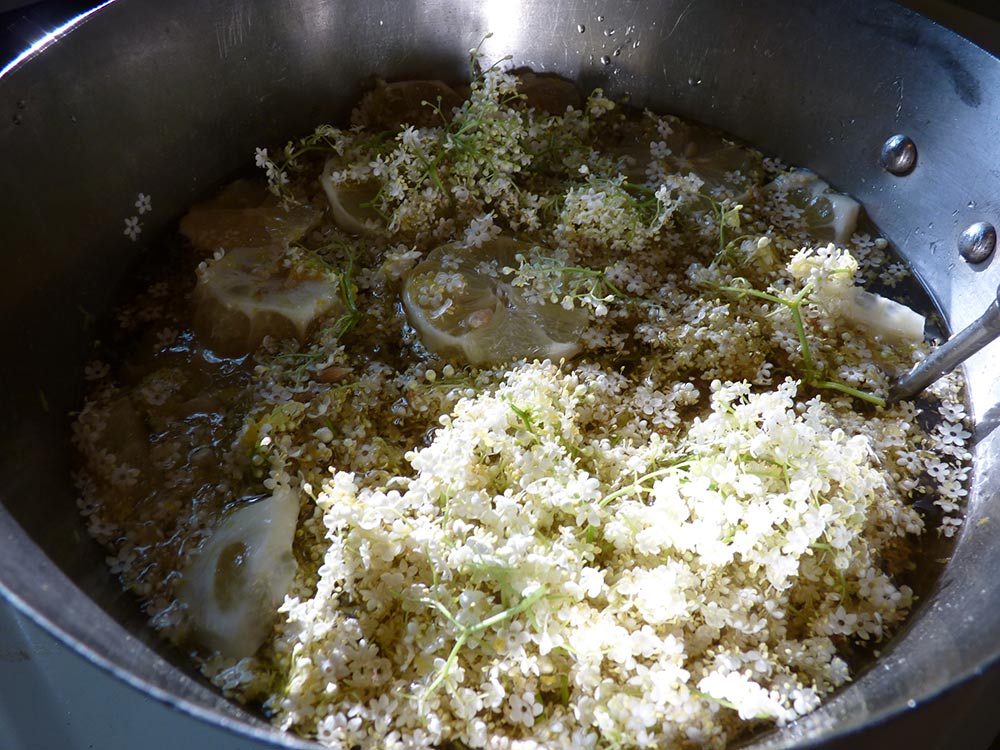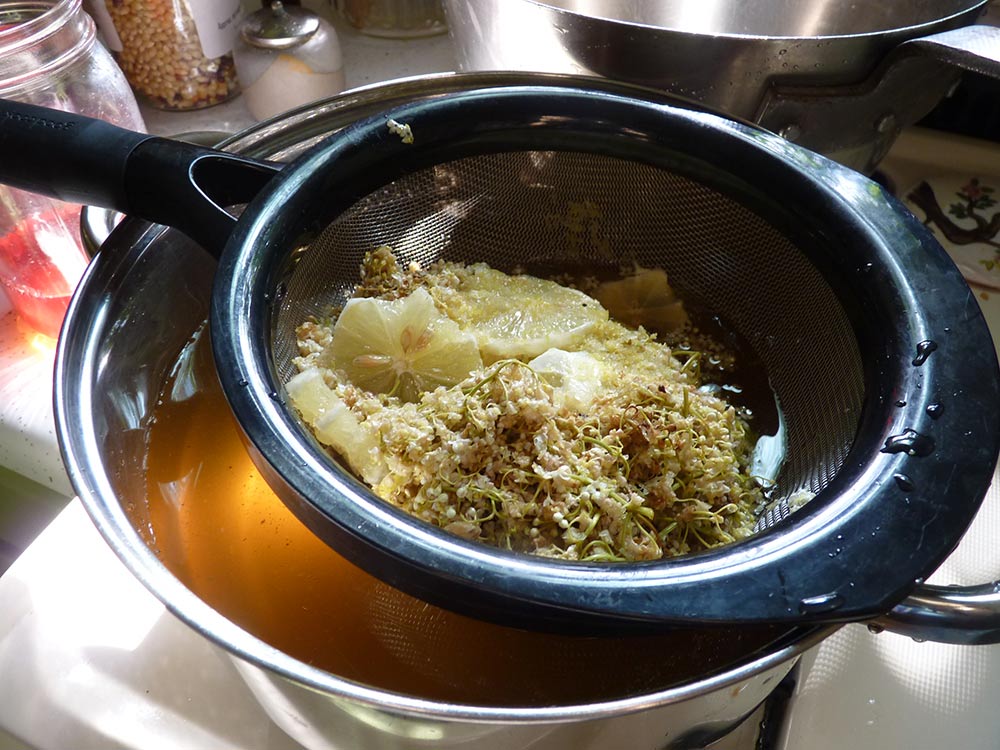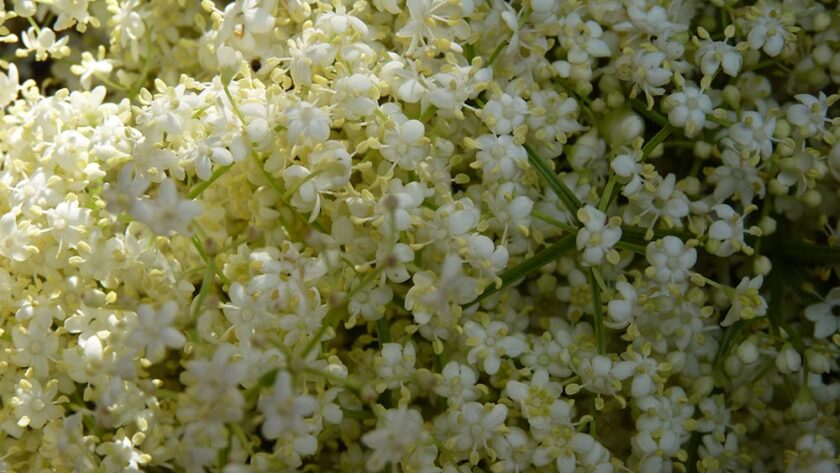Elderflowers (flowers from the Sambucus nigra plant) are in bloom right around the Summer Solstice (at least where I live), and this is a perfect time to create delightful healing recipes. One of these recipes uses raw honey (from my hives, of course) to gain the added benefits! If you are looking for recipes for elderberry available later in the season, I posted a delicious recipe for elderberry elixir last year!
Medicinal Benefits of Elderflower
Elder – both the berry and the flower– is a first-rate medicinal plant that is unmatched in its ability to bolster the immune system and fight off illness. I really enjoy having elderflower around in the winter months, especially when flu season comes around. The flowers of elder come into bloom anywhere from late May till early June depending on the season and where you live–but for me, usually they are a premiere summer solstice plant. Traditionally, elder has a very wide range of herbal uses–Grieve’s herbal details some of them. In more modern herbal practices, the flowers, specifically, are taken internally as an anti-inflammatory herb, especially for conditions in the respiratory system (like the flu, bronchitis, pleurisy and so on). It has a diaphoretic action that can be help to manage fevers–and this is how I use it, most often. If you get the flu, you want elderflower nearby! Baths of the elder flower (you can make them from dried or fresh flowers) for itchy skin also work well.

Harvesting and Preparing Elderflowers
Elder are super-easy to spot when they are in bloom–look for low to medium-sized shrubs with bunches of beautiful white flowers. They usually are margin plants, meaning they like to grow on the edges and the margins–like on the edge of a forest. You may also find them out in the middle of a field or in part shade. I’ve never found any deep in the forest. Remember that, as tempting as it may be, don’t pick elder by the side of busy roadsides as these plants are likely contaminated with exhaust (see my general suggestions for wildcrafting and foraging and avoiding toxins here.)

Once you find your elderflower, I suggest harvesting them with scissors or a knife. You can harvest them without either of these, but it does make it easier. A basket with a tight weave, a bucket, or even a cloth bag works very well to place your harvested flowers inside. I suggest giving the flowers a very good shake before placing them in–the elder are home to a number of small bugs, bees, and other creatures that you don’t want to take home with you. You want to harvest the flowers that are near full bloom or in full bloom. You also want to pay attention to the smell–different elders have different smells, and you want one that smells nice and aromatic (some of them can get a little stinky).

Once you have your elderflower safely at home, you can keep them in the fridge up to 24 hours without them going too limp, and since it does take time to harvest and process, I sometimes will harvest on one day and then process the following day.
When you are ready to process them, I suggest taking your elder outside, because the hardest part of processing elderflower is making sure none of the little bugs are still in the flowers! What I like to do (for either of these recipes) is to cut the stems off the flowers (only the flowers and berries are edible). I do this while I inspect the flowers for bugs, worms, or other critters, and gently shake or knock them off. You’ll be surprised how many there are in your flowers.
Pay attention for elders that have a really big bud–there is likely some little bug living in there (so I cut those out and leave them in a shady spot). Make sure you remove most, if not all, of the stem.

You’ll be left with a pile of lovely elder flowers ready to make delicious and medicinal concoctions!

Elderflower Infused Honey
One of the easiest ways of preserving fresh elderflowers is in raw, local honey. You get both the benefit of the honey as well as the elder flower–making this an AMAZING remedy. Infusing elderflower into honey couldn’t be easier.

Loosely pack fresh elderflowers into a mason jar and pour your honey over the flowers. Fresh honey works best for this–if your honey doesn’t pour well, you can stick it in the sun for 30 min and that will warm it up (or stick it in a bowl of hot water). If your honey is crystallized, you can stick it in a double boiler for a time and it will liquify (but don’t get it too hot or you will kill the good enzymes present in raw honey).

Once you’ve poured in the honey, take a knife or chopstick and gently stir the honey and elderflower together.

Let it sit in a warm place for 1 week, then strain the elderflower out of the honey and enjoy. Keep an eye on the honey–honey keeps because it has a low water content. The elder shouldn’t bring it above that level, but if it does, you’ll want to keep it in the fridge to prevent spoiling. I’ve never had a problem with any of my infused honeys, however, especially from herbs, but there is always that possibility.

Now you can eat this honey just like any other honey–but it has the added benefit–and flavor–of elderflower!
Elderflower Cordial
Another amazing thing to do with elderflower is to make a cordial–this recipe is for a syrup that you can add to any fizzy thing, like soda water, seltzer water, or even champagne or vodka. You can drizzle it over ice cream or enjoy it on pancakes. It also goes nicely in a tea. And the best part is that every time you take it, you are boosting the immune system!
The cordial recipe depends on if you want it to keep for a long period of time or if you are going to drink it right away. If you want to drink it quickly or freeze it, you can omit the citric acid and lemons in the recipe below. If you are going to can it (like I do) or just bottle it up and keep it in the fridge make sure you include the citric acid. If you bottle it in sterilized bottles or jars, it will keep for several months in there.
Here’s my recipe (makes about 8 cups):
2 quarts of water (8 cups)
2 quarts sugar (3 lbs sugar; I use raw sugar for this–you could also use honey or maple syrup)
8 heaping cups elder flowers, stems removed (about 30-40 heads, depending on the size of the head)
2 tsp citric acid (necessary if you are canning, otherwise, you can omit)
3 lemons, sliced and zested, pith removed (lemons are also necessary if you are canning to increase acid content, but gives it a really nice flavor)
Start by preparing your elderflowers as above. You might even dip them in water to make sure all the critters are gone, but I prefer more humane methods.

Put your sugar and water in a large stockpot and heat it up till the sugar is dissolved. While this is heating, prepare your lemons by zesting them and then cutting off the pith, and slicing the insides in small slices. Many recipes don’t remove the pith, but I know from winemaking that the pith can cause wine to go bitter, so I also remove them for this recipe.

Once the sugar water has cooled down so that you can stick your finger in it, stir in the elder flower, lemon zest, and lemon slices.


Put a lid on it and wait 24 hours.

Put a clean teatowel or fine cheesecloth in a strainer and strain the mixture. The mixture is now complete and can be enjoyed. You can pour it into sterile jars and it will keep in the fridge for 1-3 months (you’ll know when it goes bad–it usually will grow mold on it!)

At this stage, I will reheat the mixture to a slow boil, then ladle it into canning jars, and process it in a hot water bath for 10 minutes (for half-pint jars, 20 min for pints) to ensure that it will keep for several years. Not every year is a good year for elderflower, and so I will make extra in good years. I like to make this on the summer solstice and open it up at Samhuinn and the Winter Solstice to begin enjoying (and to begin bolstering my immune system for the upcoming flu season!)
Honeyed Elderflower and Lemon Tea
You didn’t think I’d let all those infused flowers go to waste after straining the honey or the cordial did you? Heck no! “Produce no waste” is a permaculture design principle that I abide by. From the honey infusion, when I strain it, I will keep the strained flowers with their bits of honey in the fridge and use them for tea within a week or two (since Grieve talks about elder being a good blood purifier and tonic, I think its great to take this tea semi-regularly anyways). Or, I will freeze it into an ice cube tray to use later.
The flowers and lemon from the cordial can likewise be dried for a tea (I do this in my dehydrator on the “herb” setting at 95 degrees, cause elderflowers are very delicate and can turn brown quickly). When its dry, I put it in a mason jar, which is good for the next year or so. Either tea will have its own sweetness already present and is delicious on its own, or mixed with other herbs. So save your flowers, brew them up, and enjoy!



Reblogged this on Chrisy58’s Weblog and commented:
Here is a wonderful article.
Thanks for the reblog!
Oh, I love this. Now I need to find some elderflowers.
They aren’t too hard to spot right now! Best of luck!
Best of luck!
Your love of elder is inspiring. Three years ago there were many elders in the area. Playing to my strengths, I waited for the flowers to become berries and helped them become the best wine I’ve ever tasted. “Next year,” I thought, “I’ll do more with this exquisite stuff.” But since then they’re nowhere to be found.
Thank you for the reminder of when they bloom, as well as reawakening my desire to seek them out!
[…] consisting of many tiny flowers. These flowers are edible and there are many recipes on this site here. The most common is elderflower cordial. As well as providing nectar for insects, the flowers are […]
Reblogged this on Rattiesforeverworldpresscom.
Totally stealing the infused honey idea, thank you!
Actually, quick question: at least for oils, I learned to use fresh wilted-herbs–I would think this will help keep the water content down in honey, too? Any disadvantages for fresh-wilted in this process?
I would use dried if you want to keep the flowers IN the honey forever. If you want to use fresh, you will change the water content, potentially too much to keep the honey preserved forever. And glad you are going to enjoy the recipe!
Great! Hope you enjoy it
I wouldn’t shake the flower heads. You’d shake off all the pollen,which is what lends the flavour to the cordial! Best picked on a dry, sunny day when the flower heads are most fragrant.
Thanks for the info, Sarah!
[…] Elder-Infused Honey […]
I realize this post is a few years old….but it is new for me.
A woman after my own heart! I also try to use as much as I possibly can from any harvest. I have a giant elderberry in full bloom. I wonder if freeze drying the flowers would work? I think I’ll experiment. Love the additional pictures of the alter. Thank you and Blessed be.
Hi Carrie! Thanks for sharing. I’m glad to hear about your giant elderberry! I have never tried to freeze dry the flowers–can you report back if you’ve done so? I’d love to hear more :).